

A Teacher’s Guide to Copyright and Fair Use. Copyright and fair use law has become a topic of concern as technology has increasingly lowered the barriers to sharing, copying, and creating at any time, making us all potential publishers and distributors of content.
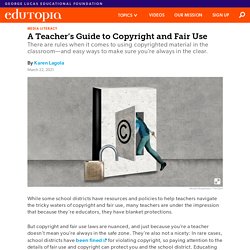
It’s become a lot easier to break the rules. Particularly in the digital age, copyright is about collective responsibility and protection—and digital citizenship. American copyright law originates in the U.S. Constitution and automatically protects all original, creative work in a fixed form; the moment a work is created, it is protected. Generally speaking, works created after January 1, 1978, are covered by copyright for a term equaling the life of the author plus 70 years after their death. The copyright for works that are not part of these exceptions is invisible and active at all times, of course, so it can be helpful to think about it like this: In most contexts, works created by others have a “No trespassing” sign on them.
A Teacher’s Guide to Copyright and Fair Use. Webinar Recording - Copyright & Creative Commons for K-12 Educators. Yesterday afternoon I hosted a free webinar titled Copyright & Creative Commons for K-12 Educators.
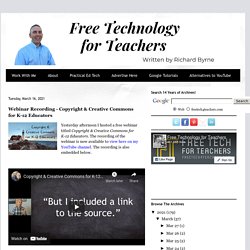
The recording of the webinar is now available to view here on my YouTube channel. The recording is also embedded below. Here's a list of the resources that I included in the webinar: Lessons from the $9.2 million copyright judgment against Houston ISD Crash Course Intellectual Property. The Educator's Guide to Creativity & Copyright.
Copyright for Students. Copyright Basics - Copyright. Codes of Best Practices - Center for Media and Social Impact. The Road to Copyright Clarity. Ethics/Copyright. Resources - Copyrightlaws.com: Copyright courses and education in plain English. Legally Using Images in Libraries - Copyrightlaws.com: Copyright courses and education in plain English. There are two perspectives to legally using images in libraries: Use of images by library staff and patronsUnderstanding how copyright pertains to images, educating staff and patrons about this, and creating a copyright culture in your library Are You Legally Using Images in Your Library?

The following are common ways libraries use images where you should consider copyright issues and permissions: In presentations and teaching materialsOn library posters and bookmarksIn bibliographies of books and book covers (see Case Study below)Images of book covers for promotional purposesIn library archival and preservation activitiesIn library social media posts Your first step in legally using images is ensuring library staff understand how copyright applies to images.
DMCA. The Digital Millennium Copyright Act (DMCA) contains two main sections that have been a source of particular controversy since they went into effect in 2000.
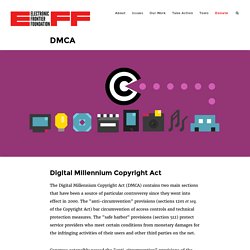
The "anti-circumvention" provisions (sections 1201 et seq. of the Copyright Act) bar circumvention of access controls and technical protection measures. The "safe harbor" provisions (section 512) protect service providers who meet certain conditions from monetary damages for the infringing activities of their users and other third parties on the net. Congress ostensibly passed the "anti-circumvention" provisions of the DMCA to discourage copyright "pirates" from defeating DRM and other content access or copy restrictions on copyrighted works, and to ban the "black box" devices intended for that purpose.
In practice the DMCA anti-circumvention provisions have done little to stop "Internet piracy. " The DMCA “safe harbors” protect service providers from monetary liability based on the allegedly infringing activities of third parties. YouTube cracks down on stream-ripping sites that pirate music. YouTube has caught the attention of a high-level congressional office interested in its copyright-protection practices, an inquiry that comes as the massive video site cracks down on stream ripping, a type of music piracy.

Stream ripping swipes audio tracks off YouTube videos and spits them out as MP3 downloads. The office of the House Judiciary Committee chairman, Rep. Jerrold Nadler of New York, reached out to Google late last week about YouTube's actions on stream ripping because of his longstanding interest in quashing piracy, according to a person familiar with the matter. A second industry source said content protection organizations outside the US have been working to verify whether YouTube has been putting new measures in place to block stream ripping. YouTube declined to comment on whether it had been contacted by Nadler's office but confirmed it has elevated its blocking of stream-ripping sites, which violate its terms of service. Three Lessons to Learn from the $9.2M Copyright Ruling Against Houston ISD. Thanks to an email from Jay Schwermer over the weekend I learned about a federal court's ruling against Houston ISD for violating the copyright of a small company called DynaStudy that sells study guides.
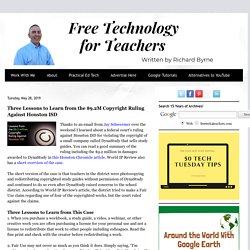
You can read a good summary of the ruling including the $9.2 million in damages awarded to DynaStudy in this Houston Chronicle article. World IP Review also has a short overview of the case. The short version of the case is that teachers in the district were photocopying and redistributing copyrighted study guides without permission of DynaStudy and continued to do so even after DynaStudy raised concerns to the school district. According to World IP Review's article, the district tried to make a Fair Use claim regarding use of four of the copyrighted works, but the court ruled against the claims. Three Lessons to Learn from This Case 1. Federal jury: HISD staff repeatedly violated copyright laws, owe company $9.2M. Charts and Tools. Fair Use Checklist. Copyright Term and the Public Domain in the United States. Download PDF (See footnote 1) Never Published, Never Registered Works2 Works Registered or First Published in the U.S.
Works First Published Outside the U.S. by Foreign Nationals or U.S. Citizens Living Abroad9 Sound recordings (Note: The following information applies only to the sound recording itself, and not to any copyrights in underlying compositions or texts.) Copyright term and the public domain2018. Digital History. A Brief History of Copyright he idea of a balance between the rights of the creators of intellectual property and the social and cultural claims of sharing and community finds support in the early history of American copyright law.
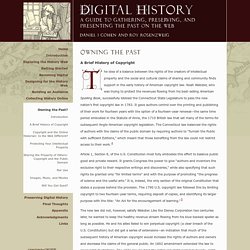
Noah Webster, who was trying to protect the revenues flowing from his best-selling American Spelling Book, successfully lobbied the Connecticut State Legislature to pass the new nation’s first copyright law in 1783. It gave authors control over the printing and publishing of their work for fourteen years with the option of a fourteen-year renewal—the same time period embodied in the Statute of Anne, the 1710 British law that set many of the terms for subsequent Anglo-American copyright legislation. Teaching Copyright. As today's tech-savvy teens become increasingly involved with technology and the Internet for learning, work, civic engagement, and entertainment, it is vital to ensure that they understand their legal rights and responsibilities under copyright law and also how the law affects creativity and innovation.
This curriculum is designed to give teachers a comprehensive set of tools to educate students about copyright while incorporating activities that exercise a variety of learning skills. Lesson topics include: the history of copyright law; the relationship between copyright and innovation; fair use and its relationship to remix culture; peer-to-peer file sharing; and the interests of the stakeholders that ultimately affect how copyright is interpreted by copyright owners, consumers, courts, lawmakers, and technology innovators.
Unit Goals Educate students about copyright law, including the concepts of fair use, free speech, and the public domain. Ohio State student copyright guide. Copyright FAQ - Educational Use. 1.

Can I scan course readings and put them up on my website for my students to read? No, not without permission of the copyright owner. Materials posted on the web could be accessed by people all over the world. Teaching Students to Legally Use Images Online. 1923 works renewed update2. Thousands of Copyrighted Works Just Entered the Public Domain in 2019. Qg copyright. The Educator’s Guide to Creativity & Copyright. Picture this! 4 steps to understanding copyright issues. Confused About Copyright Law? These Online Resources Can Help. Advertisement Are you allowed to grab that photo from Google Image Search and use it on your blog?
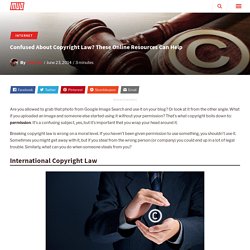
Or look at it from the other angle. What if you uploaded an image and someone else started using it without your permission? That’s what copyright boils down to: permission. It’s a confusing subject, yes, but it’s important that you wrap your head around it. 4 Reasons Why Facebook Is a Security and Privacy Nightmare. Facebook is no longer the king of the social media castle.
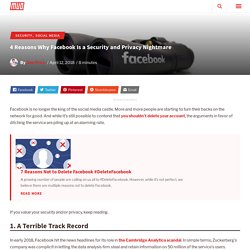
More and more people are starting to turn their backs on the network for good. And while it’s still possible to contend that you shouldn’t delete your account, the arguments in favor of ditching the service are piling up at an alarming rate. If you value your security and/or privacy, keep reading. In early 2018, Facebook hit the news headlines for its role in the Cambridge Analytica scandal. In simple terms, Zuckerberg’s company was complicit in letting the data analysis firm steal and retain information on 50 million of the service’s users. If the incident was a one-off, you might be able to forgive Facebook. Matter & Scope from copyright. Kanopy. Movie and TV Show Licensing from Swank Motion Pictures.
Confused About Copyright Law? These Online Resources Can Help. Advertisement Are you allowed to grab that photo from Google Image Search and use it on your blog? Or look at it from the other angle. What if you uploaded an image and someone else started using it without your permission? That’s what copyright boils down to: permission. It’s a confusing subject, yes, but it’s important that you wrap your head around it. Breaking copyright law is wrong on a moral level. #notataasl. DTL - Copyright Conversations NCSLMA 2017. Khloe Kardashian Sued Posting Photo Instagram Lawsuit. Know Your Copy Rights Brochure - Know Your Copyrights. A 2007 Brochure Aimed at Faculty and Teaching Assistants Among the topics covered in the brochure are: fair use, the advantage of linking to instead of copying works, and special provisions for displaying or performing works in classes.
The brochure also includes a one-page chart that highlights 24 situations when various categories of works can be used. For libraries that wish to customize the brochure, white space is available on page 3 (the bottom of the left column) where you might add the name of a local contact. Libraries are also free to use image-editing software to add their name and/or logo to the back cover of the brochure near the text that reads, "This brochure is brought to you by your institution's library.... " The Educator’s Guide to Copyright, Fair Use, and Creative Commons – The Edublogger. The Edublogs support team regularly receives complaints and official requests to remove copyrighted content that users have placed on blogs.
The legal jargon with respect to digital copyrights can be confusing – especially since different countries have their own laws and regulations. Understanding digital copyright is an essential skill we need to understand and teach our students. With this post, we hope to dispel a few myths and pull together a complete list of resources for teachers and students to use when blogging and working with content online.
This post was originally written by Ronnie Burt, on the Edublogger, on Feb, 2012. It’s been re-written with content and comments from the original post combined with updated content by Sue Waters. Rule 1: You Can’t Use Everything You Find On the Web This may seem obvious, but judging by the notices we have received, many teachers (and especially students) are under the impression that if it is on the web, then it is up for grabs. Copyright for Educators & Librarians. The Basics - Copyright for Educators - Prescott Library <i class="fa fa-home"></i> at The Wheeler School.
Copyrights and Copying Wrongs. Education World answers the question "What can my students and I freely use in our lessons, presentations, workshops, newsletters, reports, and Web sites, and what is protected by copyright? " The Copyright Genie. Summaries of Fair Use Cases - Copyright Overview by Rich Stim - Stanford Copyright and Fair Use Center. The best way to understand the flexible principle of fair use is to review actual cases decided by the courts. Compfight / A Flickr Search Tool. Compfight Safe Images Plugin – Edublogs Help and Support. The Compfight Safe Images plugin is a quick and easy tool to quickly find, add and add proper attribution for Creative Commons images to your posts.
Below is an example of an image inserted using Compfight Safe plugin: Photo Credit: Alexey Kljatov via Compfight. The Educator’s Guide to Copyright, Fair Use, and Creative Commons – The Edublogger. Copyright for Educators. Copyrights and Copying Wrongs. Strategies for Fair Use. Fair Use in Visual Arts: You Be the Judge. Artists, publishers, scholars and curators depend upon fair use in the Visual Arts more than they realize.
Silvia Tolisano- Langwitches Blog. When using Copyrighted work with written permission from owner… Used with permission from “name” , URL link to original source and or owner online presence. Citing an Image is Not Enough! I am thrilled to see so many students creating blog posts and going BEYOND “writing” text made up letters, words, sentences and paragraphs. Copyright Flowchart: Can I Use It? Yes? No? If This… Then… It is the responsibility of all educators to model good digital citizenship for their students. Know Your Copy Rights Brochure - Know Your Copyrights. MUSIC VIDEO: Copyright? What's Copyright?
TEACHER CASE STUDY VIDEO: High School. INTRO VIDEO: Code of Best Practices in Fair Use for Media Literacy Education. Copyright Clarity: Using Copyrighted Materials for Digital Learning. Copyright. Copyright poster. Don't Sell Your CDs & DVDs! 5 Downsides to Going Digital. Advertisement The world is shifting into digital gear at a rapid pace and everyone is racing to stay ahead. Video games, eBooks, music, movies, and TV shows. You name it, there’s probably a digital market for it. And while digital is awesome in many ways, it definitely isn’t perfect.
On the one hand, digital media has made it far easier for independent artists and creators to break into their respective markets. Plus, digital media is generally more convenient. Digital Ownership Is a Lie The most damning flaw in digital media — at least according to the current structure of digital distribution — is that just because you buy it doesn’t mean you own it. When you buy a CD, a DVD, a book, or a board game, you literally own that physical medium and the specific content it contains. This isn’t true when you make a digital purchase. NCWOToolkit - Copyright Support. Copyright, Memes and the Perils of Viral Content - Plagiarism Today.
Posting an Internet Meme? You May Receive a Getty Letter - Art Law Journal. How copyright is killing your favorite memes. Photographer Files $1 Billion Suit Against Getty for Licensing Her Public Domain Images. Silvia Tolisano- Langwitches Blog. Citing an Image is Not Enough! Silvia Tolisano- Langwitches Blog. Copyright Flowchart: Can I Use It? Yes? No? If This… Then… Copyright for Educators. Students: Learn important digital citizenship skills.
NCWOToolkit - Copyright Support. Copyrights and Wrongs (9-12) Copyright and Fair Use Animation Video. Untitled. Copyright issues when using music in videos. Teaching Copyright. Teaching Copyright. Video and Copyright. U.S. Copyright Office. Fair Use. Code of Best Practices in Fair Use for Online Video. Copyright Center. Five-Minute Film Festival: Copyright and Fair Use for Educators. Copyright Advisory Office Home. Music Company Does Not Own 'Happy Birthday' Song Copyright, Judge Rules. Judge Rules Warner / Chappell Doesn't Have the Rights to 'Happy Birthday' Happy Birthday Is Finally Public Domain, China's Official Linux Distro...[Tech News Digest] Teachers%20-%20Copyright%20Guidelines%20for%20Teachers.pdf. Creating the copyright problem for teachers. Copyright for Educators & Librarians - Duke University, Emory University & The University of North Carolina at Chapel Hill.
Home - Copyright and Copywrong - Library Guides at Old Dominion University. Resources - Copyright and Copywrong - Library Guides at Old Dominion University. Fair Use Evaluator. Center for Media & Social Impact. Copyright. Teacher Permission Template for Internet Resources.